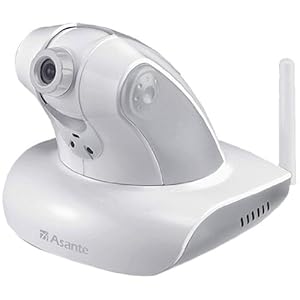I recently purchased two new IP cameras from Amazon. The Asante Voyager I and Asante Voyager II. They’re both good cameras with lots of bells and whistles, and a decent amount of configuration options that should satisfy both the geeks and a non-geek.
The reason I’m posting this is to potentially help any other new users of these cameras that may be having a similar problem.
Setup was very simple, until a snag with wifi setup.
To begin, you’ll plug-in the device to an Ethernet jack (yes, you’ll need one of those!)
There’s a utility shipped on the included disk or available for download to help discover the IP address of the camera. It’s ugly as sin (or maybe uglier?), but effective (or you can use your router if you’d like to find the camera):

(As I’ve already got the camera up, you’ll see something slightly different)
A double click on the corresponding camera launches the default web browser to the address of the camera. You’ll need the default username and password to access the web site which is provided in the documentation. If you’re running IE, it will prompt to install an ActiveX control that provides a much more “live” experience than you’ll get if you go with the QuickTime option (which is what other browsers seem to use by default). I hate ActiveX control installs like this, but this one really does make the experience better.

(The shot above is of our kitchen, it’s quite dark and the camera is in “night” mode with IR illumination. You’d not be able to identify a stranger in the image, but you could make out a person or a pet easily enough).
Next, to the network link:

Next, I clicked on wireless in the left side:

After a few moments, the list of wireless access points is displayed in the top. I selected one of the options and the SSID field is automatically filled in below.
Click [Next Step].
Here’s where the major frustration occurred. The authentication settings.

After spending SEVERAL hours experimenting and grumbling a LOT in my den, I gave up. I could not get it to work. After countless failures with our household wireless access points (we’ve got 3), I dug out my old Apple Airport Express so that I could try lots of things without messing up all of the wireless devices in the house.
Failures. I rebooted that Airport Express about 4 gagillion times.
I wrote support at Asante and for the most part, they did try very hard to help (and quite rapidly). They tried to replicate what I was experiencing, but couldn’t seem to duplicate the problem my setup was experiencing: “can not connect.” It was very frustrating. (Hey, and they even called and stayed late to help! Thanks Roger!)
Without encryption, things worked fine, but with it on, nothing repeatable.
Here’s what I learned:
Because of the crappy way that the web page transmits the password from the web browser to the device, don’t expect symbols to work with only a few exceptions: ! works, * probably works, and a few others. I lost a number of hours to that issue before I spelunked and debugged my way through the JavaScript code to discover what it was not doing with my password that I had expected (encoding it). So, stick with alphanumerics and a few basic symbols and you should be OK. Do not use colon, ampersand, slash, backslash, percent, @, … and probably more. Furthermore, passwords of great length (> 16?) may not work. That I can’t explain, but it happened to me that they did not work even with only letters.
Also, if you’ve got a wireless access device that supports WPA/WPA2 Personal …

Be sure to use WPA-PSK and TKIP. You’ll likely have MUCH greater success. I could not get WPA2 to work, period.

With the changes above:
- Password for wifi network simplified
- WPA and TKIP
Everything works like a charm. Both cameras are now setup and being monitored (I’m still using Blue Iris, which I’d highly recommend – it works really well (I’ve got it running on Windows Home Server 2011, has lots of great features and should be priced at least twice what he’s asking!).

Note that this camera is also manufactured as several other labels:
- Asante
- A-Linking
- VisionxIP
- SmartGuard (this one may be dead though?)
They all use the same firmware, so problems with one are likely to happen on others.
If you have any questions about the device that aren’t answered on the manufacturer’s web pages, please post a comment and I’ll see if I can help!




